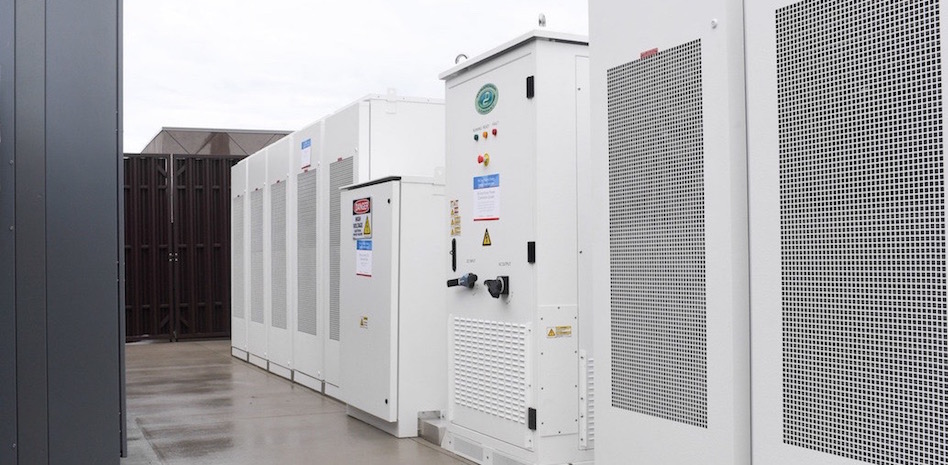While energy storage may not be economically viable yet in most residential solar markets, the commercial and utility-scale sectors present a different picture, with cheaper battery prices making storage already competitive there.
Still, much of the attention on storage has been focused on areas with high solar penetration like Hawaii, Australia, and California. Now one of the largest U.S. power companies, serving more than 9 million customers in nine states across the country, is putting utility-scale storage to the test in Florida with the Tesla Powerpack.
Southern Company and its Gulf Power subsidiary have launched a battery storage research project at Gulf Power’s Douglas L. McCrary Training and Storm Center in Pensacola, Florida. The McCrary Battery Energy Storage Demonstration was developed in collaboration with the Electric Power Research Institute’s Integrated Grid Initiative and Tesla.
The project, to be run over a two-year period, will test and evaluate a 250 kW/1 MWh Tesla Powerpack lithium-ion industrial energy storage system. Southern Company says the project closely simulates a commercial or industrial facility operation.
The goal of the project, according to Southern Company, is to better understand the siting, installation, and operational requirements of commercial and industrial energy storage systems.
“At Southern Company, we are constantly broadening our industry-leading expertise to harness new technologies that can deliver clean, safe, reliable, affordable energy to customers,” said Southern Company Executive Vice President and CEO Kimberly S. Greene in a press release. “This collaborative research project with Gulf Power will deepen our understanding of battery energy storage systems and the value they can provide.”
The project will evaluate how storage can benefit both customers and energy providers with peak shaving, demand management, ancillary services, energy arbitrage, and backup power. Resiliency and cost savings for customers are other potential benefits being studied.
Southern Company already has some residential, commercial, industrial, and utility-scale battery projects in their Southeastern electric service territory. And its subsidiary PowerSecure is joining with Advanced Microgrid Solutions, a California company that builds customized energy storage fleets for commercial and industrial users and utilities, to develop and deploy behind-the-meter distributed energy resources across the U.S. But this is their first project to use the Tesla Powerpack. And it’s the first storage project to date within the operating territory of Gulf Power, which wanted to gain experience in siting, installing, and operating a storage system.
In addition, said Schuyler Baehman, a spokesperson for Southern Company, “This is the first project within our regulated electric footprint done at this scale, a scale that is impactful to our commercial/industrial clients.” Southern Company expects the insights gained from the project to accelerate their deployment of battery storage technology.
Does this mean a new commitment to renewable energy on the part of the power company? Despite touting the Tesla project as “another important milestone in its work to build the future of energy,” and despite its other ventures into energy storage, and despite its investments in wind and solar, Southern Company isn’t all about renewable energy. The company has remained strongly committed to nuclear power, though that focus hasn’t come without issues — as when Southern recently took over construction of a project from Westinghouse that ran into major cost overruns. Other recent projects have included a “clean coal” plant, which had to be abandoned because of high costs.
When asked about the company’s focus in the near future, Baehman gave a stock answer: “Southern Company will continue its commitment to a leadership role in finding environmental solutions that make technological and economic sense.” This is not a company that wants to waste money, whatever its leadership may think of nuclear and “clean coal.”
Perhaps Southern Company is realizing that renewables and energy storage are becoming more viable options in today’s market. The McCrary Battery Energy Storage Demonstration is much smaller than some other Tesla Powerpack installations, like Kaua’i’s 52 MWh battery storage project, Southern California Edison’s 80 MWh facility, or the upcoming largest-of-its-kind 129 MWh storage system in Australia. And while Southern Company is testing, others are moving ahead with deploying. But this modest installation is for a huge power company — one whose territory extends well beyond high-penetration regions like Hawaii and California. Let’s hope this small project reflects a big step forward in energy storage.
This content is protected by copyright and may not be reused. If you want to cooperate with us and would like to reuse some of our content, please contact: editors@pv-magazine.com.








By submitting this form you agree to pv magazine using your data for the purposes of publishing your comment.
Your personal data will only be disclosed or otherwise transmitted to third parties for the purposes of spam filtering or if this is necessary for technical maintenance of the website. Any other transfer to third parties will not take place unless this is justified on the basis of applicable data protection regulations or if pv magazine is legally obliged to do so.
You may revoke this consent at any time with effect for the future, in which case your personal data will be deleted immediately. Otherwise, your data will be deleted if pv magazine has processed your request or the purpose of data storage is fulfilled.
Further information on data privacy can be found in our Data Protection Policy.